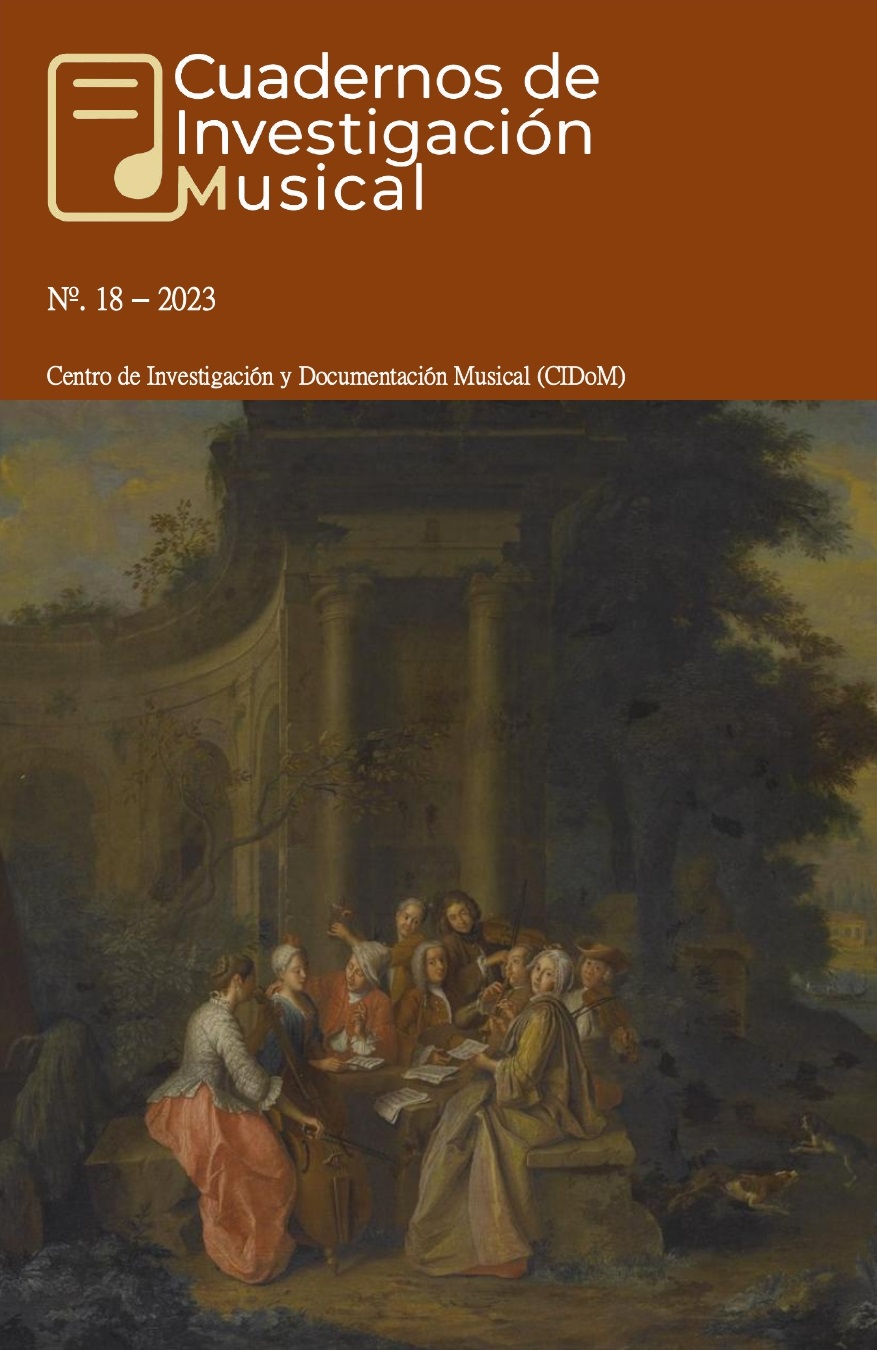The whole-tone scale: historiographic perspective
Main Article Content
Abstract
A historiographic review –not exhaustive– related to the whole-tone scale is not only necessary to support the state of knowledge about the material; it will also be useful if it allows to establish a starting point towards new and interrelated paths of compositional application, for the advancement of disciplines such as music theory and analysis and, in any case, for a better understanding of its presence within the historical evolutionary process of Western music in general.
Article Details

This work is licensed under a Creative Commons Attribution-NonCommercial-NoDerivatives 4.0 International License.
Los autores de los artículos mantienen el copyright, no recibirán ninguna contraprestación económica por el trabajo y el mismo siempre será reconocido como exclusivamente suyo. La revista se compromete a proteger la integridad y originalidad del artículo, así como los derechos de autor que correspondan. Los autores son los únicos responsables del material, textos e imágenes que utilizan en sus respectivos trabajos, debiendo respetar siempre los derechos de autor de terceras personas, por lo que la revista no se hace responsable de lo contenido en este tema respecto al trabajo de los autores.
References
Andrews, H. K. (2001). Whole-tone. New Grove music. https://doi.org/10.1093/gmo/9781561592630.article.30242.
Balsach i Peig, Ll. (1994). La convergència Harmònica. Morfogènesis dels acords i de les escales musicals. Barcelona: Clivis.
Costère, E. (1954). Lois et Styles des Harmonies Musicales. París: Presses Universitaires de France.
Danièlou, A. (1959). Traité de musicologie comparée. París: Hermann.
De la Motte, D. (1989). Armonía [Juan José Olives, rev.]. Barcelona: Labor.
Gauldin, R. (2009). La práctica armónica en la música tonal. Madrid: Akal.
Gerald, A. (1933). The Whole-Tone in Russian Music. The Musical Times, 74, pp. 602-604.
Grabner, H. (2001). Teoría general de la Música [Joaquín Chamorro, ed.]. Madrid: Akal.
Haba, A. (1979). Neue Harmonielehre des diatonischen-, Chromatischen-, Viertel-, Drittel-, Dechstel-, und Zwölftel-Tonsystems. München: Musikverlag.
Hauer, J. M. (1923). Atonale Musik Op.20. Klavierstücke. Den Freudenden und Gönnern meines Werkes dankbar gewidet. Berlín: Schlesinger.
Hindemith, P. (1974). Unterweisung im Tonsatz. Göppingen: Verlag Alfred Kummerle.
Benavente, J. M. (1983). Aproximación al lenguaje de Joaquín Turina. Madrid: Publicaciones del CSM de Sevilla y Editorial Alpuerto.
Jurafsky, A. (1946). Manual de Armonía. Buenos Aires: Ricordi.
Leblanc, M. (1989). Franz Schubert: un pas vers l’atonalite. Canadian University Music Review, 9, pp. 84-115.
Messiaen, O. (1993). Técnica de mi lenguaje musical [Daniel Bravo, trad.]. París: Alphonse Leduc.
Moevs, R. (1969). Intervallic Procedures in Debussy: Serenade from the Sonata for Cello and Piano, 1915. Perspectives of New Music, 8(1), pp. 82-101.
Persichetti, V. (1985). Armonía del siglo XX. Madrid: Real Musical.
Piston, W. (1991). Armonía. Mark Devoto, rev. Barcelona: Ed. Labor.
Schönberg, A. (1922). Harmonielehre. Wien: Universal Edition.
Schönberg, A. (1969). Structural Function of Harmony [Leonard Stein, trad.]. New York: W. W. Norton.
Searle, H. (1957). El contrapunto del siglo XX. Guía para estudiantes [Rosendo Llates, trad.]. Barcelona: Vergara Editorial.
Taruskin, R. (1985). Chernomor to Kashchei: Harmonic Sorcery; o, Stravinsky's Angle. Journal of the American Musicological Society, 38, pp. 72-142.
Woodside, M. S. (1990). Leitmotiv in Russia: Glinka’s Use of the Whole-Tone Scale. 19th-Century Music, 14(1), pp. 67-74.
